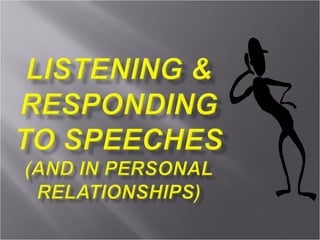
M1 listening feedback
- 2. Hearing The physical process of sound ways striking the eardrum and causing vibrations. Listening The reaction when the brain reconstructs these electrochemical impulses and then gives them meaning. Therefore…we can hear without listening… but can we listen without hearing?
- 3. Hearing the act of perceiving sound by the ear. If you are not hearing-impaired, hearing simply happens. Listening something you consciously choose to do. Listening requires concentration so that your brain processes meaning from words and sentences. Therefore…people can be "hard of listening” rather than "hard of hearing."
- 4. is intermittent is a learned skill is active implies using and interpreting the message received
- 5. You get the You focus on You attach You integrate You judge the You decide stimuli stimuli meanings to the message merits of the what to do with stimuli into your frame information the information of reference Receive Select Interpret Understand Evaluate Respond This process is experienced in RAPID succession…OVER and OVER…
- 6. Physical distractions Physiological distractions Psychological distractions Factual distractions Semantic distractions
- 7. Lack of interest – “I don’t care” Distracting delivery – fidgeting, dress/attire External/Internal noise – external sounds, internal thoughts Arrogance and disrespect – know-it-all Pre-programmed emotional response– bias Listening for facts – don’t gain big picture Faking attention – look the part Thought speed – think faster than we talk Other barriers – tiredness, insincerity (Surely none of us have ever experienced these reactions to listening!)
- 8. Remove physical barriers to listening. Focus on the speaker’s main idea. Listen for the intent as well as the content of the message. Give the other person a full hearing. Remember the saying “meanings are in people not words”. Concentrate on the person as a communicator and as a human being.
- 9. Desire to listen. Focus on the message. Listen for main ideas. Understand the person’s point of view. Reinforce the message. Provide feedback. Listen with the body. Listen critically, but withhold judgment.
Editor's Notes
- .
- 3
- 4
- 4 Barriers to Active Listening… Lack of interest – “I don’t care” Distracting delivery – fidgeting, dress External/Internal noise – sounds/thoughts Arrogance and disrespect – know-it-all Pre-programmed emotional response Listening for facts – don’t gain big picture Faking attention – look the part Thought speed – think faster than we talk Other barriers – tiredness, insincerity
- 5